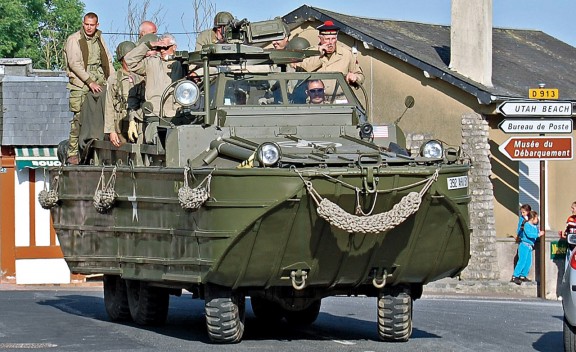World War II
The DUKW was supplied to the U.S. Army, U.S. Marine Corps and Allied forces. 2,000 were supplied to Britain under the Lend-Lease program and 535 were acquired by Australian forces. 586 were supplied to the Soviet Union, which built its own version, the BAV 485, after the war.
DUKWs were initially sent to the Pacific theatre’s Guadalcanal, and were used by an invasion force for the first time during the Sicilian Operation Husky in the Mediterranean. They were used on the D-Day beaches of Normandy and in the Battle of the Scheldt, Operation Veritable and Operation Plunder. Amphibious beachheads were thought to be highly vulnerable to early counterattack as the landing units would deplete their ammunition and the supply system would not yet be established. The principal use was to ferry supplies from ship to shore, and tasks such as transporting wounded combatants to hospital ships or operations in flooded (polder) landscape
Post-war
After World War II, reduced numbers were kept in service by the United States, Britain, France and Australia, with many stored pending disposal. Australia transferred many to Citizens Military Force units.
The U.S. Army reactivated and deployed several hundred at the outbreak of the Korean War with the 1st Transportation Replacement Training Group providing crew training. DUKWs were used extensively to bring supplies ashore during the Battle of Pusan Perimeter and in the amphibious landings at Incheon.
Ex-U.S. Army DUKWs were transferred to the French military after World War II and were used by the Troupes de marine and naval commandos. Many were used for general utility duties in overseas territories. France deployed DUKWs to French Indochina during the First Indochina War. Some French DUKWs were given new hulls in the 1970s, with the last being retired in 1982.
Britain deployed DUKWs to Malaya during the Malayan Emergency of 1948–60. Many were redeployed to Borneo during the Indonesia–Malaysia confrontation of 1962–66.
Later military use
The Royal Marines use five of these vehicles for training at 11 (Amphibious Trials and Training) Squadron, 1 Assault Group Royal Marines at Instow, North Devon. Four were manufactured between 1943 and 1945. The fifth is a DUKW hull copy manufactured in 1993 with unused World War II vintage running gear parts. In 1999, a refurbishment programme began to extend their service life to 2014.
The DUKWs are used for safety, allowing all ranks to undertake training drills for boat work for the landing craft ranks, and drivers undertaking wading drills from the Landing Craft Utility.
Civilian use
Many were used by civilian organizations such as the police, fire departments and rescue units.
The Australian Army lent two DUKWs and crew to Australian National Antarctic Research Expeditions for a 1948 expedition to Macquarie Island. Australian DUKWs were used on Antarctic supply voyages until 1970. From 1945 to 1965, the Australian Commonwealth Lighthouse Service supply ship Cape York carried ex-Army DUKWs for supplying lighthouses on remote islands.
Several were used by abalone fishermen in San Luis Obispo County, California to take their catch from the boats directly to market, combining the two steps of off-loading onto smaller craft and transferring to trucks once they reached the beach.
DUKWs are well equipped for the land and water rescue. Australian Army Reserve DUKWs were used extensively for rescue and transport during the 1955 Hunter Valley floods.
One of the last DUKWs manufactured in 1945 was loaned to a fire department during the Great Flood of 1993, and in 2005 Duck Riders of Grapevine, Texas deployed the vehicle to help in the aftermath of Hurricane Katrina. The DUKW maneuvered through flood waters, transporting victims stranded on their rooftops to helicopter pads throughout New Orleans.
A few, such as the “Moby Duck”, have been adapted by local groups like Seattle’s Seafair Pirates, for parades and other events.
One DUKW is in use by the Technisches Hilfswerk (THW) of Germersheim in Germany, a public organization supplying technical support.
